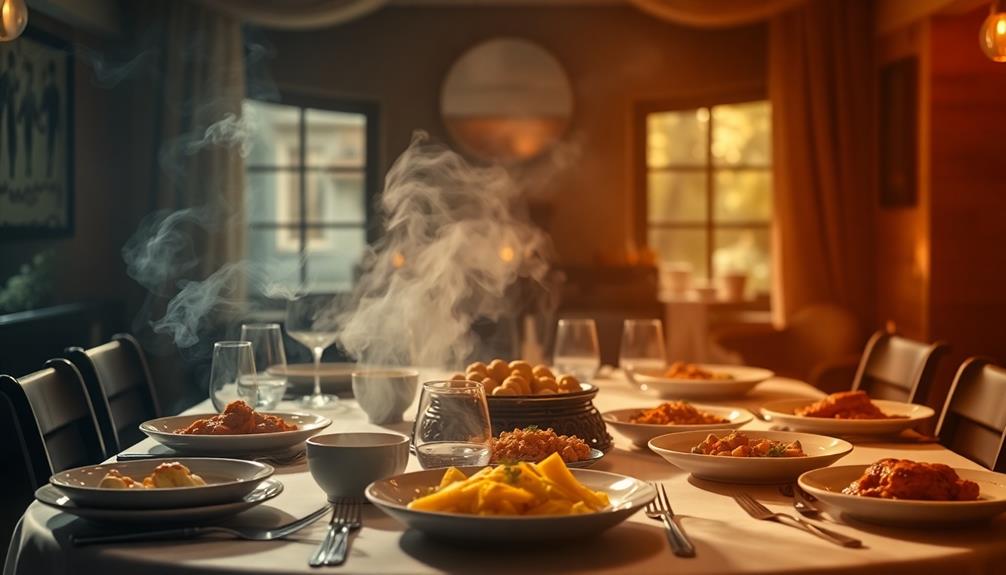Food cravings among the older population are influenced by physiological, psychological, and environmental factors. As individuals age, their cravings tend to lessen in both diversity and strength, especially when it comes to sugary treats and unhealthy snacks. While women may still yearn for chocolate more than men, these desires typically decrease due to hormonal shifts. Moreover, cognitive decline can impact how individuals perceive food cues, while emotional ties to familiar foods can lead to cravings fueled by nostalgia. Recognizing these factors can aid in making wiser dietary decisions and effectively managing cravings. If you’re intrigued by ways to navigate these cravings, there’s a wealth of information waiting to be uncovered.
Key Takeaways
- Aging leads to a decrease in the number and variety of food cravings, with fewer reported by elderly individuals than younger adults.
- Hormonal and metabolic changes result in diminished cravings for sweets, particularly among elderly women who typically crave chocolate.
- Cognitive decline affects food cue recognition, limiting food variety and influencing cravings in older adults.
- Emotional and environmental factors, including nostalgia and social settings, can trigger specific cravings, often for comfort foods.
- Adopting mindful eating practices and a balanced diet can help manage cravings and improve overall nutritional intake in the elderly.
Understanding Food Cravings

Have you ever wondered how food cravings change as we age? For the elderly, food cravings tend to be fewer in number and variety compared to younger adults.
Curiously, cravings for sweets and junk food decline markedly as you get older. You might notice that elderly individuals often show a lack of response to dietary monotony, meaning the variety or restriction of foods doesn’t strongly influence their cravings.
Comforting dishes like Mushroom Masala may evoke nostalgia and enhance their dining experience. Women in this demographic often report cravings similar to younger individuals but don’t experience an uptick during periods of dietary monotony.
You’ll find that cravings among older adults typically peak in the late afternoon and early evening, indicating specific times of day can influence what they desire to eat.
Psychological factors, like cognitive capacity, might play a role in the reduced food cravings seen in the elderly. Diminished cravings could lead to inadequate dietary intake, affecting overall health.
Understanding these dynamics can help you appreciate how aging impacts food cravings and dietary choices, ensuring you maintain a balanced diet as you navigate these changes.
Age-Related Changes in Cravings
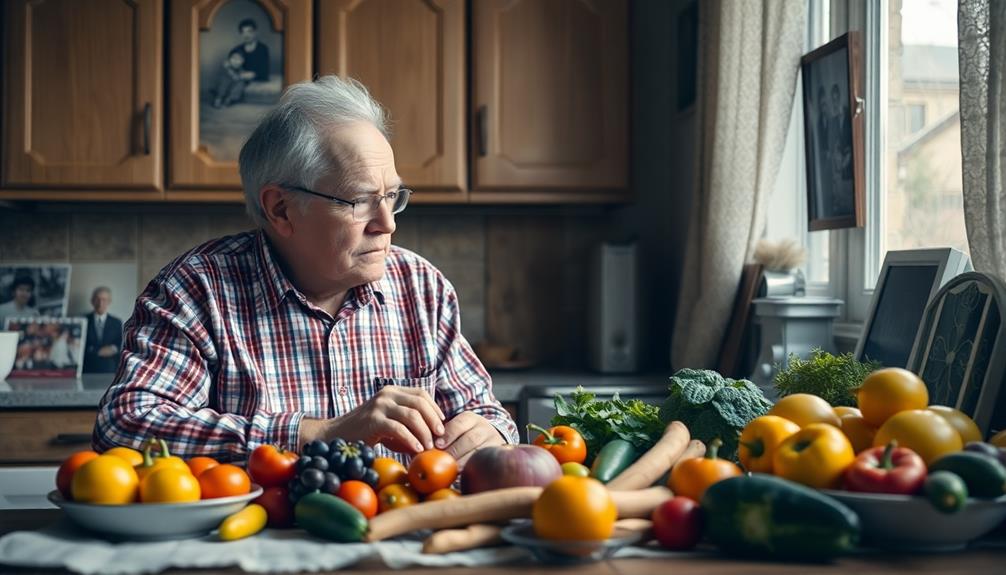
As you age, you might notice a decline in food cravings, which can differ greatly from what younger adults experience. This change may reduce interest in certain flavors and textures, influencing meal choices.
Gender differences also play a role, with elderly women often craving sweets less than before, while men show more consistency in their preferences.
Your cognitive capacity may also influence your response to dietary changes, affecting your overall cravings. For instance, some older adults may find themselves drawn to familiar dishes, such as traditional stuffed pasta, which can evoke nostalgia and comfort.
Decline in Food Cravings
Many elderly individuals experience a noticeable decline in food cravings compared to their younger counterparts. Research shows that elderly participants report markedly fewer cravings, with some elderly men showing almost none during studies. This decline can be attributed to age-related changes in food preferences, leading to a smaller variety of foods that you may crave.
For instance, women’s cravings for sweets, particularly chocolate, often diminish as they age, while men display less variation in their cravings. Additionally, traditional dishes like Red-Braised Pork Belly may not be craved as intensely, reflecting the shift in taste preferences over time.
Young adults typically experience heightened cravings during periods of dietary monotony, but you might find that your response to such changes is minimal. This diminished reaction can be linked to cognitive capacity, which may affect your ability to seek out diverse food options.
If these changes go unaddressed, they could lead to inadequate diets, impacting your overall health.
Awareness of these shifts in food cravings and preferences is essential. By actively seeking out a variety of nutritious foods, you can combat the decline in cravings and maintain a balanced diet, ensuring you meet your dietary needs as you age.
Gender Differences Observed
Gender differences in food cravings among the elderly reveal significant variations in how cravings manifest with age. Research shows that elderly women often report cravings similar to younger adults, but unlike younger individuals, they don’t experience increased cravings during periods of dietary monotony. This suggests a decline in overall cravings as they age.
Notably, cravings for traditional comfort foods, such as Chilaquiles, may also shape preferences. Women consistently exhibit higher cravings for sweets, especially chocolate, compared to men, and this trend remains evident in older age groups.
Notably, women’s cravings for sweets seem to decrease with age, likely influenced by hormonal factors that affect dietary preferences.
On the other hand, elderly men display almost no cravings during studies, highlighting a stark contrast in craving patterns between genders within older populations.
Cognitive Capacity Influence
Cognitive capacity plays a significant role in how food cravings change with age. As you age, your cognitive capacity may decline, affecting how you recognize and respond to food cues. This decline can lead to a reduced craving response in elderly individuals, which might help explain why you experience less variety in food cravings compared to younger adults.
Seasonal dishes, like Nettle and Potato Soup, may not be as readily craved due to these cognitive shifts. Notably, while elderly women often show baseline cravings similar to younger adults, they don’t exhibit an increase in cravings during dietary monotony. This suggests that cognitive processing differences may influence food preferences and choices, limiting your ability to recall past cravings.
Moreover, studies indicate that elderly men report minimal cravings, highlighting how cognitive capacity impacts food desire. Without adequate craving responses, you might struggle to maintain an adequate dietary intake, which can have serious health implications.
Gender Differences in Food Preferences

When you think about food cravings, gender differences play a significant role.
Research shows that women often crave sweets, especially chocolate, more than men, and this trend shifts as they age.
For instance, older women may also find themselves drawn to comforting dishes like turkey soup, which can evoke nostalgic feelings associated with family gatherings.
Understanding these preferences can help you appreciate how hormonal changes and age impact what you crave over time.
Cravings for Sweet Foods
Many elderly individuals experience distinct cravings for sweet foods, and studies show that these cravings often differ between men and women. Research indicates that elderly women tend to exhibit cravings for sweets, particularly chocolate, similar to younger adults. However, these cravings often decline with age, reflecting shifts in food preferences and dietary desires over time.
Additionally, cultural influences can shape these cravings, as seen in regions where traditional sweets, like Brigadeiro, are cherished. In fact, women consistently report higher cravings for sweets compared to men, highlighting notable gender differences in food choices. This difference may stem from hormonal changes that women experience as they age, which can impact their cravings and preferences.
While cravings for sweets are common among younger adults, elderly individuals, particularly men, tend to report fewer cravings overall, suggesting that age-related changes in dietary desires play a significant role.
As you navigate your food choices, it’s important to recognize how these cravings may evolve. Understanding the influences of gender and age on your cravings for sweets can help you make informed decisions about your diet, ensuring it aligns with your health goals while still satisfying your sweet tooth.
Gender-Specific Food Preferences
Understanding gender-specific food preferences can shed light on how your cravings might differ from those of others. Research shows that gender differences play a significant role in food cravings among the elderly. Here are some key points to reflect upon:
- Cravings for sweets: Elderly women often experience stronger cravings for chocolate and sweets compared to elderly men, although these cravings may decline with age. This aligns with the general appeal of sweet treats like Dorayaki (Red Bean Pancake), which are popular among many age groups, including the elderly.
- Dietary monotony: Elderly women report similar baseline cravings as younger adults but show no increase during periods of dietary monotony, suggesting a shift in food preferences over time.
- Hormonal factors: Women’s cravings for sweet foods can be influenced by hormonal changes, especially during life stages like pregnancy, but these influences diminish in older age.
- Nutritional intake: Elderly men typically show minimal cravings, which can impact their nutritional intake and highlight age-related differences in food preferences.
Age-Related Preference Changes
Age-related changes in food preferences highlight significant gender differences that can impact dietary habits among the elderly. You might notice that elderly women often experience stronger cravings for sweet foods, especially chocolate, compared to men. This reflects a key gender difference in food preferences.
As you age, cravings for sweets generally decrease, particularly among older women, likely due to hormonal changes and metabolic alterations affecting taste and desire. Notably, traditional desserts such as Kue Putu may appeal to these cravings due to their sweet coconut and palm sugar flavor, offering a comforting treat.
Elderly individuals report a smaller variety of craved foods than younger adults, who typically express a broader range of food desires. This narrowing of preferences can lead to less diverse diets. You may find that elderly women are more health-conscious, often steering clear of unhealthy foods, a shift that emphasizes their changing priorities as they age.
Furthermore, cravings tend to peak during specific times of the day, particularly in the late afternoon and early evening, which may vary by gender.
Recognizing these age-related changes in food preferences can help you better understand the evolving cravings and dietary choices of the elderly, allowing for more tailored nutritional support.
Psychological Influences on Cravings
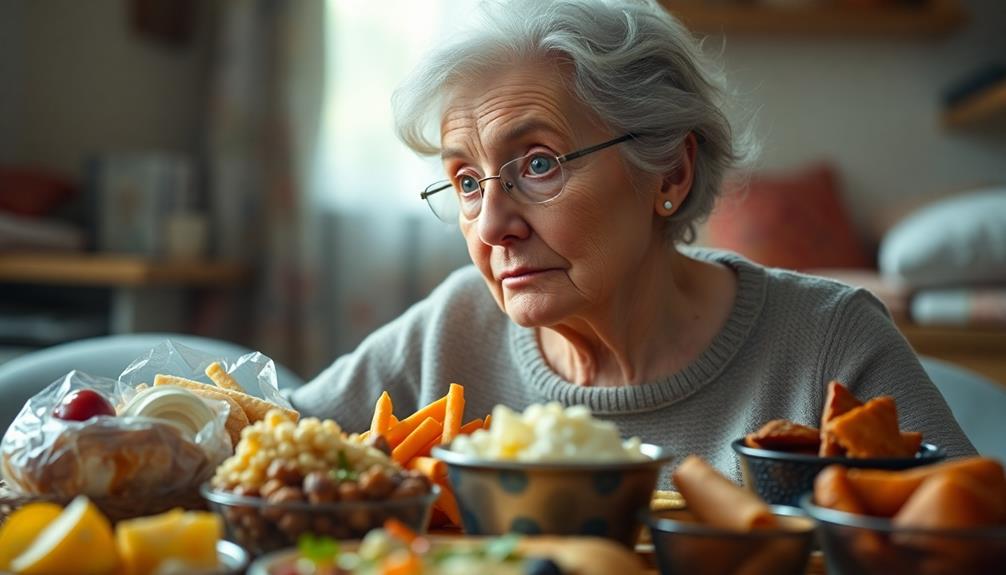
While cravings can arise from various sources, psychological influences play an essential role in shaping food desires among the elderly. You might find that your food cravings stem from a mix of emotional and cognitive factors. For instance, cravings for specific comfort foods like squash casserole can evoke warm memories of family gatherings.
Here are four key influences to contemplate:
- Emotional Eating: Food often becomes a source of comfort during stressful times or sadness. This pattern can lead to cravings for specific comfort foods.
- Conditioned Responses: Over time, certain internal and external cues—like the smell of baked goods—can trigger intense cravings linked to past experiences.
- Nostalgic Associations: Cravings may arise from memories tied to particular foods, reminding you of cherished moments or family gatherings.
- Environmental Factors: Social settings and meal timing can intensify cravings. Being around others who are eating can lead to a stronger desire for food.
Understanding these psychological factors can help you develop effective dietary strategies. By becoming aware of your cravings and the emotions behind them, you can make more mindful choices and manage your food desires better.
Neuroanatomy of Food Craving
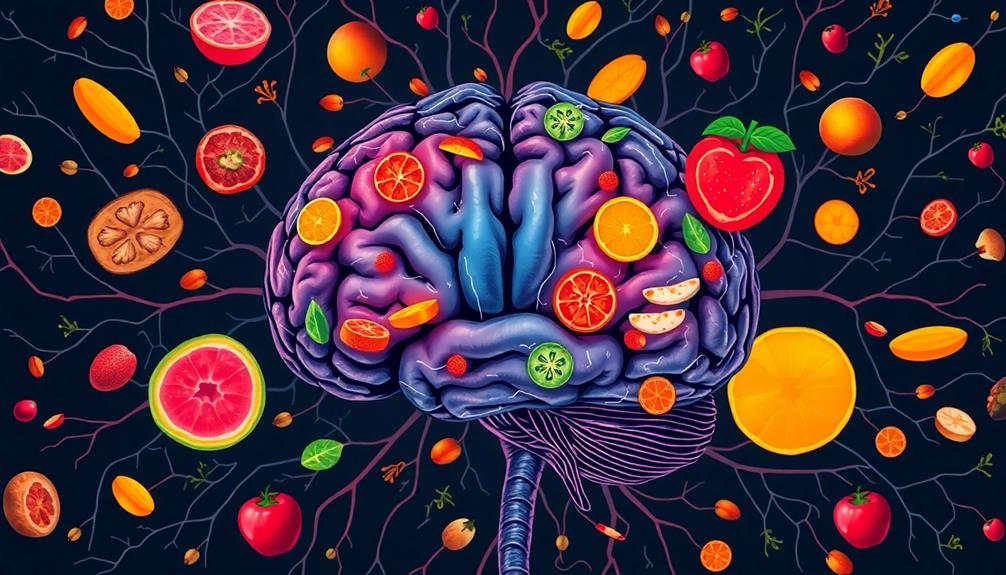
Food cravings in the elderly are closely linked to specific brain regions that play significant roles in memory, emotion, and awareness. The neuroanatomy involved in these cravings includes the hippocampus, insula, and caudate.
The hippocampus, responsible for emotional responses and memory, suggests that your past experiences with food can heavily influence what you crave today. This connection can make cravings more intense based on your dietary conditions.
The insula plays an important role in interoceptive awareness, helping you recognize hunger and cravings. As you age, this awareness might diminish, complicating your ability to regulate your eating habits effectively.
The caudate, another key player, is involved in reward processing and can further amplify your cravings by associating specific foods with positive feelings.
Together, these brain regions demonstrate how cravings in the elderly can be affected by both physiological and psychological factors. Understanding the neuroanatomy behind food cravings can shed light on why self-regulation in dieting becomes more challenging and highlight the importance of tailored approaches to managing cravings as you age.
Impact of Diet on Cravings
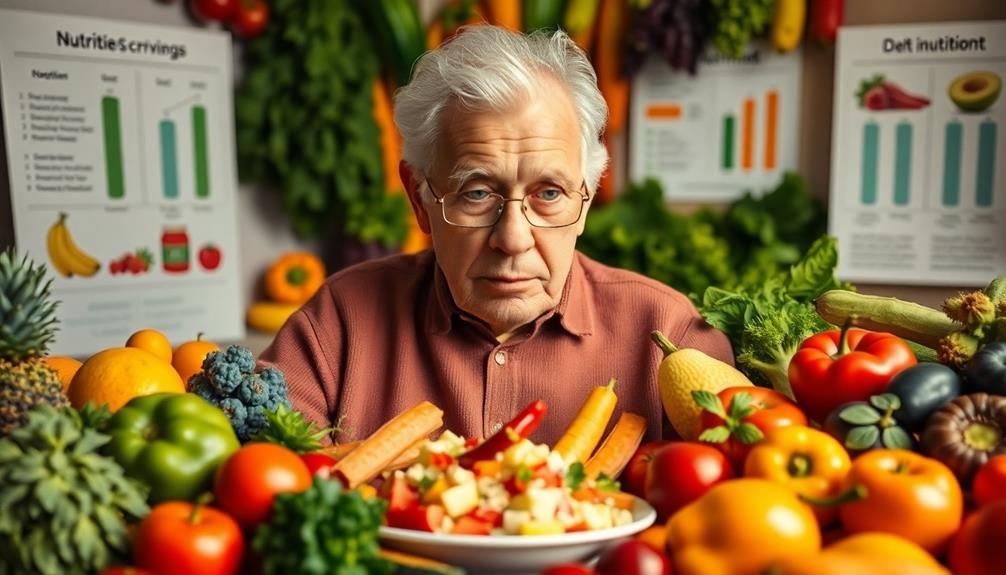
Diet plays a significant role in shaping cravings among the elderly. As you navigate your dietary choices, understanding how these choices impact your cravings is crucial.
Here are four key factors to reflect on:
- Dietary Restrictions: Adhering to strict dietary guidelines can increase cravings, making it essential to find a balance that meets nutritional needs without feeling deprived.
- Dietary Monotony: A limited variety of foods can result in fewer food cravings. Introducing diverse flavors and textures can help combat this monotony and enhance your meals.
- Craving Patterns: Research indicates that cravings peak in the late afternoon and early evening. Strategic meal planning around these times can help you manage cravings more effectively.
- Nutritional Status: Improving your overall nutritional status can reduce the intensity and frequency of cravings. Focus on nutrient-dense foods to support your health.
Therapeutic Approaches to Manage Cravings
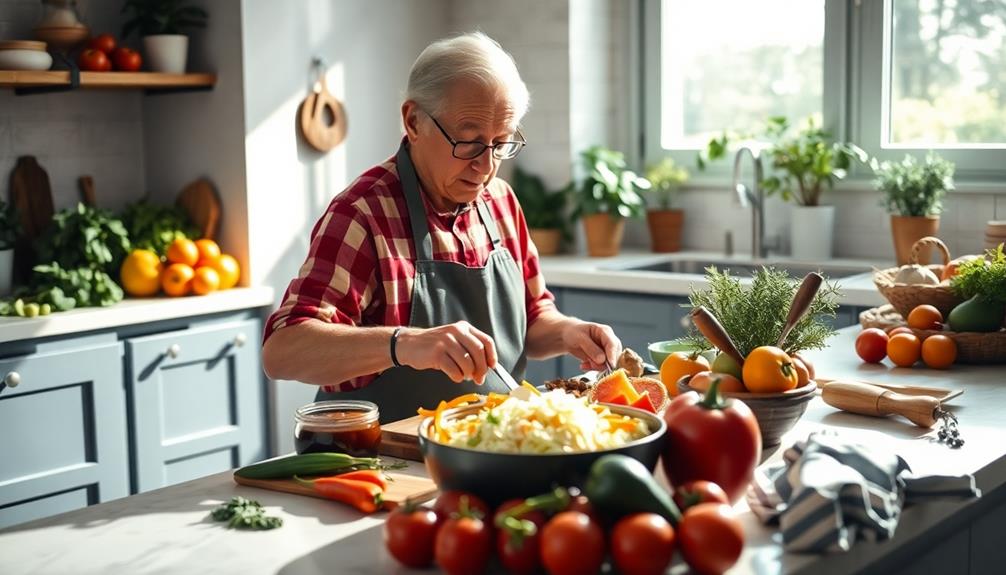
Managing cravings effectively in the elderly requires a multifaceted approach that goes beyond dietary adjustments. One promising strategy is the combination of naltrexone and bupropion, which has shown significant results in reducing cravings and weight among older adults.
Personalized treatment can enhance dietary adherence, especially since many elderly individuals experience fewer cravings yet face dietary restrictions that may impact their well-being.
Understanding the psychological factors behind cravings is essential. Emotional eating patterns often play a role in the elderly, so tailored therapeutic strategies are important.
Behavioral interventions focusing on self-regulation techniques can empower you to manage cravings more effectively. Incorporating mindful eating practices can also help you become more aware of your eating habits, leading to better control over cravings.
Additionally, understanding the neuroanatomy of cravings can inform targeted interventions, ensuring that you’re addressing the root causes of your cravings rather than just the symptoms.
Long-Term Health Goals and Food Choices

Many older adults find that their long-term health goals shape their food choices considerably. As you focus on improving your health, it’s important to align your nutrition with these aspirations.
The elderly population faces increased risks of diabetes, making dietary changes crucial for managing health outcomes.
Here are four strategies to reflect on:
- Prioritize whole plant-based foods: These foods are rich in nutrients and can help manage cravings effectively.
- Aim for healthier options: By choosing low-sugar alternatives, you can reduce the risk of diabetes and enhance your overall well-being.
- Educate yourself about food as medicine: Understanding the long-term benefits of your food choices can empower you to stick to your goals.
- Recognize cravings: Acknowledging your cravings allows you to make conscious decisions, steering you towards better food choices.
Frequently Asked Questions
What Is the Psychological Reason for Food Cravings?
Food cravings often stem from emotional associations and conditioned responses. When you encounter specific food cues, your mind links them to past experiences, triggering desires that can override hunger and lead to indulgence.
What Is the Chemistry Behind Cravings?
Cravings stem from complex chemical interactions in your brain. Neurotransmitters like dopamine and serotonin signal pleasure, while hormonal changes influence appetite. Your body’s chemistry drives the desire for specific foods, often linked to rewards and emotional states.
Why Does My Elderly Mother Only Want to Eat Sweets?
Your elderly mother might crave sweets due to nostalgic memories or emotional comfort. As taste perception changes with age, she may find sugary foods more appealing, using them as a reward or source of joy.
What Vitamin Deficiency Causes Food Cravings?
Vitamin deficiencies, especially in B12, D, and magnesium, can trigger food cravings. When you lack these nutrients, your body signals for high-energy or sweet foods to compensate, making you feel hungrier for specific items.
Conclusion
In understanding food cravings, especially in the elderly, you’ll find that they’re influenced by a mix of biological, psychological, and social factors. Notably, some theories suggest that nostalgia plays a significant role—cravings for specific foods often stem from cherished memories. By acknowledging these cravings and their roots, you can better manage them. Ultimately, balancing these desires with healthy choices can lead to improved well-being, helping you stay on track with your long-term health goals.

